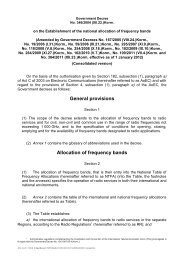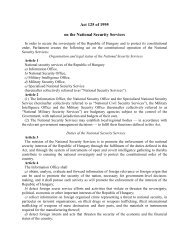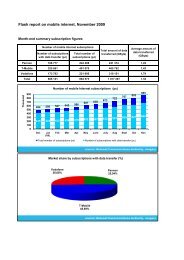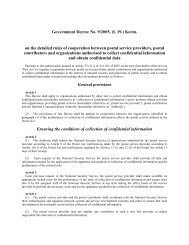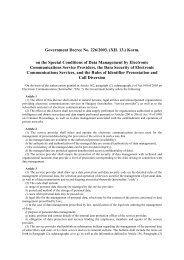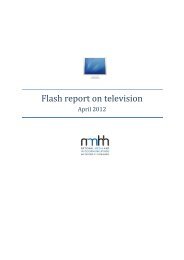The Hungarian Communications Market Developments and ...
The Hungarian Communications Market Developments and ...
The Hungarian Communications Market Developments and ...
Create successful ePaper yourself
Turn your PDF publications into a flip-book with our unique Google optimized e-Paper software.
18 19<br />
purposes of WMAN, which was completed by a study on the use of<br />
these b<strong>and</strong>s. <strong>The</strong> Authority has also prepared for the opening of the<br />
3.5 GHz “midb<strong>and</strong>”.<br />
<strong>The</strong> tender for the UMTS spectrum license took place in 2004.<br />
During the preparation phase, the Authority also took measures<br />
to provide access to GSM, DCS <strong>and</strong> UMTS b<strong>and</strong>s, which may be<br />
necessary for the operation of a potential fourth mobile service<br />
provider. Although a fourth service provider failed to obtain a license<br />
for frequency use in 2004, in addition to the three GSM/DCS service<br />
providers purchasing the UMTS license at that time, the frequency<br />
remains to be available for a fourth entrant.<br />
In 2007, mobile service providers’ GSM licenses for b<strong>and</strong> usage<br />
starting their operation in 1993 was extended to 2016, subject to the<br />
condition that such service providers pay a one-off fee of net HUF<br />
10 billion <strong>and</strong> invest net HUF 20 billion in Hungary over the next two<br />
years, in addition to their originally planned developments. Following<br />
such development, mobile broadb<strong>and</strong> services will be available in<br />
every town of a population of 1,000 people or more, representing 90<br />
percent of the territory of Hungary <strong>and</strong> 98 percent of the population.<br />
On 22 October 2008, invitations to tender to facilitate the market<br />
entry of new service providers were announced with the aim of<br />
boosting competition in the mobile telephone market <strong>and</strong> increasing<br />
the coverage of broadb<strong>and</strong> Internet services. <strong>The</strong> two tenders are<br />
to facilitate the market entry of a mobile service provider <strong>and</strong> a wireless<br />
radiocommunication service provider in the GSM/UMTS range<br />
(900/1800/2100 MHz) <strong>and</strong> the 450 MHz range, respectively.<br />
Five invitations to tender were announced for the 26 GHz microwave<br />
wideb<strong>and</strong> connections. <strong>The</strong> entry of new mobile service providers <strong>and</strong><br />
the simultaneous opening of the 26 GHz frequency range may significantly<br />
increase competition in the market of mobile <strong>and</strong> broadb<strong>and</strong><br />
Internet services, whilst greatly improving Internet coverage in lessfavoured<br />
regions of the country, including sparsely populated areas.<br />
<strong>The</strong> so-called WAPECS principle 18 is an essential element of the<br />
EU spectrum reform. Along this principle, full technology <strong>and</strong> service<br />
neutrality of terrestrial radiocommunication is to be ensured in certain<br />
frequency b<strong>and</strong>s. Through the implementation of the WAPECS<br />
principle, broadb<strong>and</strong> Internet access systems may become mobile<br />
to enable the provision of a wide range of services (e.g. broadb<strong>and</strong><br />
Internet transmission <strong>and</strong> programme transmission). In order to<br />
implement the WAPECS principle, the Authority made the 3.5 GHz<br />
broadb<strong>and</strong> transmission b<strong>and</strong> accessible by fully guaranteeing technology<br />
neutrality. With this step, the future introduction of mobility<br />
(e.g. mobile WiMAX) has already been prepared.<br />
<strong>The</strong> most efficient means of selling frequencies is by auctioning.<br />
<strong>The</strong> multi-player international market expects modern <strong>and</strong> efficient<br />
market management. An essential procedure of primary spectrum<br />
trade is the so-called “parallel auction”. Within the framework of preparatory<br />
work, the development of auction methodology has started:<br />
the Authority has defined the basic technical specification data for<br />
a multi-purpose electronic remote auction system <strong>and</strong> prepared the<br />
document describing this system.<br />
Broadcasting<br />
With the purpose of satisfying broadcasting needs <strong>and</strong> ensuring<br />
undisturbed operation, the Authority continuously performs activities<br />
concerning the planning, international coordination, putting into service,<br />
<strong>and</strong> tendering of broadcasting stations, as well as the protection<br />
of the broadcasting market, as laid down in Rttv. 19 <strong>and</strong> Eht.<br />
In connection with the introduction of digital broadcasting, the Authority<br />
has examined the possibilities of implementing the GE’06 20 plan,<br />
identified the locations <strong>and</strong> channels where switching of channels or<br />
power increase is required, <strong>and</strong>, if necessary, initiated international coordination<br />
procedures. In order to prepare for T-DAB 21 b<strong>and</strong> allocations,<br />
as laid down in the GE’06 plan, the Authority has elaborated theoretical<br />
assignments in connection with the frequency zones <strong>and</strong>, in accordance<br />
with the procedural rules of GE’06, started international coordination<br />
as regards the conversion of allocations to assignments.<br />
In order to prepare for the introduction of digital broadcasting in<br />
Hungary, the Authority has held continuous coordinating consultations<br />
with the representatives of foreign organisations falling within the zone<br />
of coordination. As a result of this work, coverage indicators increased<br />
to 94, 82 <strong>and</strong> 81 percent for the first three multiplexes, respectively.<br />
<strong>The</strong> plans of the national DVB-T transmission network comprising<br />
some sixty transmitters have been completed. With reference to announcing<br />
the digital broadcasting tender, the Authority has developed<br />
the technical requirements for frequency use.<br />
<strong>The</strong> tendering procedure as regards national digital television <strong>and</strong><br />
radio multiplexes took place in 2008. In the two separate tenders,<br />
Antenna Hungária (AH) acquired the operating license for five television<br />
multiplexes <strong>and</strong> one radio multiplex for 12 years. Of these multiplexes,<br />
AH will start broadcasting the radio multiplex, television multiplexes “A”<br />
<strong>and</strong> “C” as well as “B” as part of mobile television service as early as<br />
in 2008, whilst service is scheduled to start in multiplexes “D” <strong>and</strong> “E”<br />
after the termination of the current analogue terrestrial broadcasting in<br />
2011. After complete rollout of the network, DVB-T television multiplexes<br />
will reach 96 percent of the population, <strong>and</strong> population coverage<br />
of 94 percent is anticipated in the case of the radio multiplex.<br />
<strong>The</strong> introduction of terrestrial digital television service is expected<br />
to boost competition <strong>and</strong> broaden market supply. Simultaneously, it<br />
will contribute to the fact that in the future a higher quality <strong>and</strong> wider<br />
selection of programmes than today will be available to about 20<br />
to 25 percent of <strong>Hungarian</strong> households currently having television<br />
transmission through indoor or rooftop aerials.




